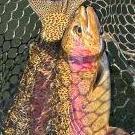Our generation schedule here on Lake Taneycomo has been almost exactly the same every day for the month of August with very few exceptions. The water is off every morning, while generation starts about 1 p.m. continuing until dark or after. The flow is dictated by how hot it is on that day, meaning how much generation is needed to produce electricity. So that being said, as fall temperatures arrive, we should see slower flows in the afternoon. But I don't think the pattern of no generation in the mornings will change.
Our lake temperature is about 53 degrees while the dissolved oxygen content has plummeted to two parts per million (raw water coming through the turbines.) This is normal for this time of year. Liquid oxygen is injected into the turbines during generation, bringing the DO levels up to five ppm-plus. This will continue until Table Rock "turns over" later in December.
While fishing Friday morning, I took water readings just above the Narrows in the trophy area and found the DO to be five ppm and the temperature 55 degrees. I also found the trout I caught very strong and active.
There are reports that good-sized brown trout have arrived at the hatchery outlets below the dam. This brown trout run should continue through the month of October, and with low lake levels in the system, we should see a lot of down water for ideal fly fishing conditions through the run this year.
Very good catches of browns and rainbows have been reported on stripping sculpin flies, wooly buggers, cracklebacks and soft hackles, as well as midges and scuds. Egg flies should start showing up on the top of our lists for good flies to use later in September. For night fly fishing, stripping a PMS, sculpins, leaches and other streamers should be hot for weeks to come. Also use a glow indicator and a black mega worm or a black 1/50th ounce jig under it.
In and out of the trophy area, when the water is off, we're using a mop fly or mega worm in white, cream and peach under a float and good catching some nice browns as well as rainbows. Also, the 50th-ounce black jig is out-producing most other colors of jigs, even in still, clear conditions. The Zebra Midge is working most of the time under a float. Good colors are black with red rib, red flash with red rib and root beer with black rib, all with a black tungsten head. But there's a midge that's doing very well and that's the "snow cone" midge. It's a white head and fished with black/red rib or black with gold rib. Use size, but #18 to #20 in still condition and #14 to #16 if there's a chop. Use 7x fluorocarbon tippet in most conditions, but if the water is running you can go to 6x.
Scuds are working fair when the water is off and good with it running. The Provo rig is our guides' choice to drift flies. Fish an egg and a scud combo with the scud on the bottom.
We usually get a fair topwater bite in the fall, and after a very good cicada bite in June, I thought this year our trout would be looking up more than past years. I believe I’m right!
We’re seeing a lot of activity on top lately, along the banks and out in the middle of the lake. And we’re also a good number of takes using hoppers, cicadas, beetles, ants and other terrestrial flies. This bite should continue through October.
You can also drift a scud using a spin cast. I just tie the fly at the end of the line and add a split shot 18 inches above it. The size of the split shot depends on how much water is running. Use two- or four-pound line. And use a #14 to #18 size scud.
Drifting below the trophy area has been pretty good lately, especially down at Monkey Island. I've found a good number of rainbows down there eager to eat. I've used both Power Eggs (pink) and night crawlers and have done exceptionally well when the water is running. I've also used minnows up in the area of the resort and caught some nice rainbows. Use four-pound line.
Our guides have been catching big trout on jerk baits early and late in the day. They are starting before daylight most mornings and the good bite ends before 7 a.m. Starting about 5 p.m., the bite is good along any bluff bank and continues well into the night.
Look at the colors in this brown Darren Sadler caught the other day. Amazing!






Recommended Comments
Create an account or sign in to comment
You need to be a member in order to leave a comment
Create an account
Sign up for a new account in our community. It's easy!
Register a new accountSign in
Already have an account? Sign in here.
Sign In Now